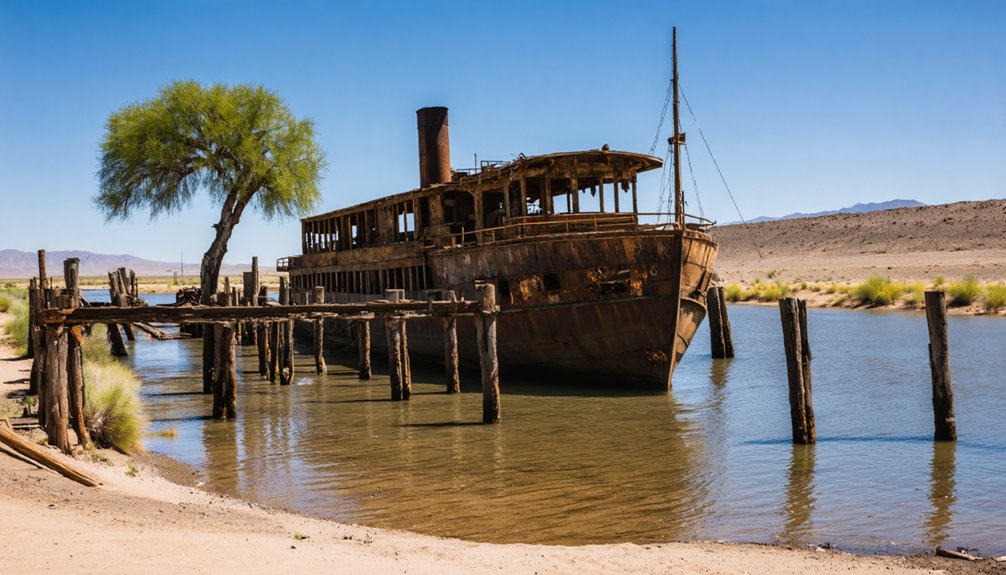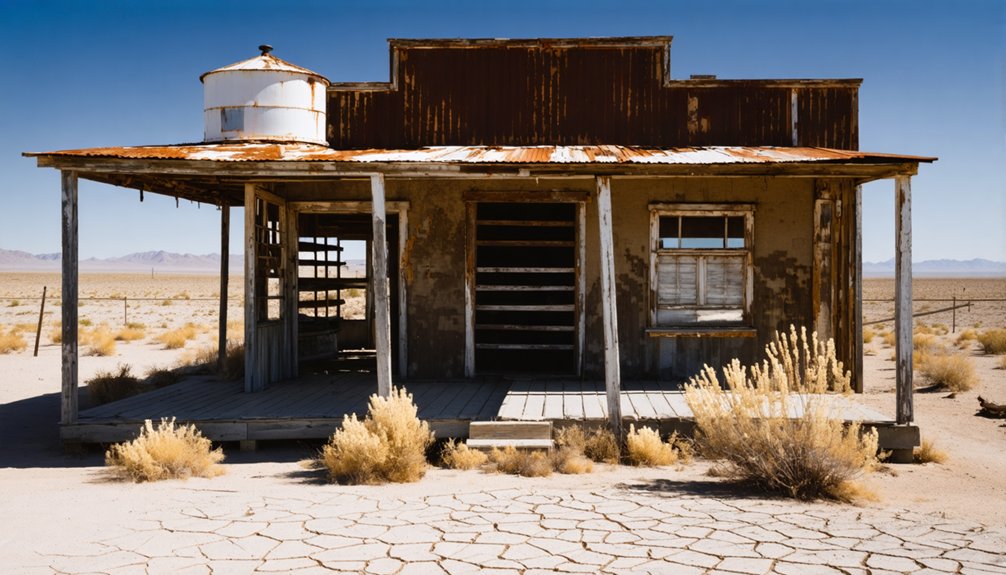Hardyville was once a thriving Colorado River port established in 1864 at the intersection with the Mojave Road. You’ll find it served as Mohave County’s first seat with approximately 20 residents during its peak years. The settlement declined after losing county seat status in 1873 and was further undermined by railroad development. Today, only Hardyville Cemetery remains with 17 original graves, offering a glimpse into Arizona’s territorial frontier life.
Key Takeaways
- Hardyville, established in 1864 at the Colorado River and Mojave Road intersection, was an important desert river port in early Arizona Territory.
- The town served as the first Mohave County seat until 1873, featuring warehouses, wharves, and steamboat connections to wider markets.
- Economic decline began when the Southern Pacific Railroad bypassed the settlement, causing river traffic to dwindle.
- Today, only Hardyville Cemetery remains, featuring 17 original graves marked by cobblestone piles.
- The cemetery, located at 1776 Arizona State Route 95 in Bullhead City, is listed on the National Register of Historic Places.
The Rise of a Desert River Port (1864-1873)

Three essential factors converged in 1864 to establish Hardyville as an important desert river port.
William Harrison Hardy, a New York native, strategically positioned his settlement at the critical intersection of the Colorado River and Mojave Road, creating a crucial transportation nexus.
Hardy’s strategic placement of Hardyville where the Colorado River meets the Mojave Road created a vital desert crossroads.
You’ll find Hardyville’s regional significance stemmed from its role as the first Mohave County seat and home to the area’s first U.S. Post Office.
The port quickly evolved into a bustling hub featuring warehouses, wharves, and a five-stamp quartz mill.
Transportation innovations included Hardy’s Mohave-Prescott Toll Road, which shortened travel to the territorial capital by 6-8 miles.
Steamboats like the Cocopah and Mohave regularly docked here, connecting this desert outpost to the wider world via the Colorado River’s liquid highway.
The settlement’s emergence was partly driven by the need to supply growing mining communities as traditional supply lines were disrupted during the Civil War.
Hardy’s entrepreneurial spirit was evident in his diverse business ventures including a mercantile store, hotel, saloon, and ferry service that served the community.
Life Along the Colorado: Daily Existence in Hardyville
While nestled along the unpredictable Colorado River, Hardyville maintained a modest but resilient community of approximately 20 permanent residents during its peak in the late 1860s and early 1870s.
Your daily life would’ve revolved around the rhythms of river commerce, with steamboats bringing essential supplies and travelers.
Community interactions centered on Hardy’s mercantile, hotel, and saloon—the social hubs where miners, traders, and stagecoach drivers gathered.
As the county seat, you’d witness governmental proceedings alongside commercial transactions.
Daily struggles were numerous: fires ravaged buildings in 1872-73; the river claimed lives through drowning; childbirth posed severe risks without proper medical care; and supply shortages occurred when river levels affected navigation.
The cemetery tells stories of these hardships—blacksmiths shot, stagecoach drivers meeting accidental deaths, and mothers lost during childbirth. Nearby Mojave tribes, comprised of distinct Matha lyathum clan members and others, occasionally traded with Hardyville residents and shared their knowledge of local agriculture techniques.
The steamboat landing was critical to Hardyville’s existence, serving as the primary point for receiving mining supplies and shipping out valuable minerals from nearby operations.
Economic Decline and Abandonment
Hardyville’s descent into abandonment began when it lost its status as Mohave County seat in 1873, marking the first significant blow to the settlement’s prominence.
This political demotion, coupled with dramatic economic shifts in transportation and mining, sealed the town’s fate. You can trace Hardyville’s decline through several key developments that transformed this once-thriving river port into a ghost town.
- Southern Pacific Railroad’s 1881 completion created alternative shipping routes
- Railroad crossings at Topock and Needles (1883) bypassed Hardyville entirely
- Steamboat traffic dwindled as rail transport proved faster and more reliable
- Silver price collapse in the late 1880s devastated local mining operations
- Population trends showed steady exodus until only adobe ruins remained by 1900
The town’s final demise was accelerated by two destructive fires in 1872 and 1873, which damaged much of the remaining infrastructure and discouraged rebuilding efforts.
The Legacy of William H. Hardy
William H. Hardy’s legacy extends far beyond the ghost town that bears his name.
You’ll find his innovations woven into Arizona’s territorial development—from the riveted mail sack he invented to the essential transportation network he established between Hardyville and regional mining communities.
Hardy’s political influence shaped early Arizona governance during his service in the Territorial Legislature from 1867 to 1873.
As a county supervisor and prison commissioner, he helped establish foundational infrastructure while Hardyville served as Mohave County’s seat.
Though he left for California after the railroad diminished Hardyville’s importance, his manuscripts preserved at the Autry Museum offer glimpses into frontier life. His collection of undated typed manuscripts provides valuable historical accounts of Arizona from 1867 to 1887. The Arizona Historical Society has been instrumental in connecting people to Hardy’s contributions through its extensive collections and research resources.
The New York-born businessman-turned-pioneer exemplified the entrepreneurial spirit that tamed the Colorado River corridor and connected Arizona’s isolated settlements during a pivotal era of western expansion.
Visiting Hardyville Cemetery: The Last Remnant
Today, only a single physical trace remains of Hardy’s once-thriving river port: the Hardyville Cemetery.
You’ll find this historic site at 1776 Arizona State Route 95 in Bullhead City, perched on a bluff overlooking the Colorado River. The 2.5-acre cemetery preserves the authentic character of frontier Arizona through its 17 graves marked by original cobblestone piles. The site offers visitors a glimpse into the past as it is the only surviving remnant of Hardyville.
- Located near modern conveniences like Safeway while maintaining its historical significance
- Contains documented burials including Adelida Amaro and William J. Tuttle, revealing insights into territorial life
- Accessible directly from Highway 95 with clear directional signage
- Recognized on the National Register of Historic Places since 2001
- Represents the cornerstone of cemetery preservation efforts for Arizona’s territorial heritage
The cemetery is approximately 100 feet square in size, making it a compact but historically rich destination for visitors interested in Arizona’s territorial past.
Frequently Asked Questions
Did Native American Tribes Interact With Hardyville Residents?
Yes, you’ll find Mohave people engaged in complex trade relations with Hardyville settlers through ferry operations, food provision, and mercantile transactions, though these cultural exchanges occurred alongside territorial conflicts and displacement.
What Foods and Supplies Were Commonly Available in Hardyville?
You’d find staples like flour, beans and rice alongside canned goods using primitive canning methods. Despite limited local agriculture, you’d have access to dried fruits, preserved meats, and essential mining tools.
Were There Any Schools or Churches in Hardyville?
You won’t find evidence of schools or churches in historical records. Hardyville’s small population, commercial focus, and brief prominence likely prevented the development of formal school history or church presence.
How Did Residents Cope With the Extreme Desert Heat?
As the scorching sun beats down, you’d adapt to desert survival by building adobe homes with thick walls, working during cooler hours, rationing water, and wearing loose-fitting clothes to combat heat adaptation challenges.
What Alternative Industries Were Attempted After Steamboat Decline?
You’ll find that mining attempts in Cerbat district provided temporary relief, while ferry operations and toll road services persisted. Agricultural ventures weren’t viable due to the harsh desert conditions and water limitations.
References
- https://www.arizonan.com/ghost-towns/hardyville/
- https://www.bullheadareachamber.com/hardyville-to-bullhead-city
- https://jandlresearchandexploration.blogspot.com/2018/05/hardyville-az.html
- https://www.ghosttowns.com/states/az/hardyville.html
- http://www.apcrp.org/HARDYVILLE/Hardyville_Cem_Text_011109.htm
- https://www.vvdailypress.com/story/news/local/desert-dispatch/2020/05/30/beyer-8217-s-byways-them/1128316007/
- https://winfirst.wixsite.com/arizonamininghistory/hardyville
- https://npgallery.nps.gov/GetAsset/199da66b-26fb-4852-9839-487ab9fc2edc
- https://www.msavhcc.org/hardyville-to-bullhead-city
- https://theclio.com/entry/108502



